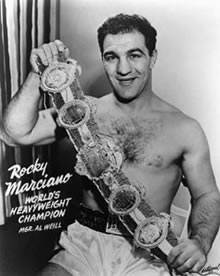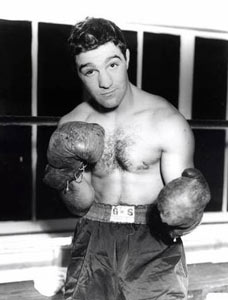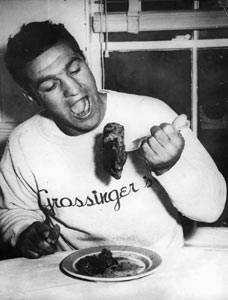
|
 |

Rocky Marciano’s Toughest Opponent
Greg Smith - 6/15/2006
Photo Credit www.rockymarciano.net
“I learned what pain was all about when I fought him.”
---Rocky Marciano reminiscing about his toughest opponent
Rocky Marciano was an aberration. He was cut from a different cloth, and his heavyweight record of 49-0 (43 KOs) may continue to remain for decades to come. He didn’t practice conventional boxing technique. He was often clumsy, but always effective. The wreckage of broken and thoroughly beaten opponents in his wake is an example of something highly unusual and almost mystical, despite the fact that Marciano was as humble, polite, and down-to-earth as any high profile champion we’ve ever seen.
I’ll remember him as the Joe Montana of boxing. Both men were understated and unassuming, but underneath their steady demeanors, they possessed an eerily unflappable determination, and they were vicious and frighteningly effective in clutch situations. Perhaps it’s because both men grew up in rock solid, blue-collar communities. Montana grew up in the factory culture of Pittsburgh’s Mon Valley. Marciano grew up in working class Brockton, Massachusetts. Marciano and Montana were inculcated and tempered in a granite-like foundation of hard work and old-world values. They realized early in life that good things don’t come easy. Success comes through using your mind and body for opportunity. They knew if you just kept working at it, the job would get done.
The similarities between both men end with their professional styles. Marciano was a brutal, swarming fighter who overcame physical deficiencies with pluck, endurance, and power. In contrast, Montana was an elegant minimalist. He could pick a defense apart with stunning calmness and laser-like efficiency.
Interestingly, Marciano’s toughest opponent was actually similar to Montana in style. Quiet, sedate, and unobtrusive, Marciano’s toughest opponent was a classical, elegant stylist of the highest order. He had analyzed, dissected, and defeated the best of his generation. Nonetheless, despite the fact that he came closer than any opponent in ending the unbeaten streak and reign of the “Brockton Blockbuster”, he indeed fell short like all the rest.
In May 2005, I wrote up a career retrospective on former heavyweight champion Ezzard Charles. The title of the column was “Ezzard Charles: Subtle Greatness.” In the column, I ranked Charles as one of the top 5 fighters of his special era. At the time, I didn’t feel as though the depth and totality of Charles’ career accomplishments had been properly appreciated. In my opinion, his accomplishments from middleweight to heavyweight are astonishing, and very few fighters in boxing history actually match up favorably with Charles as it applies to the true success of his career, and the legacy he left behind.
Realistically, he was kind of a rich man’s Charley Burley. In kind, he easily defeated Burley twice as a young, fledgling middleweight in 1942. Like Burley, however, Charles was the kind of slick, yet restrained practitioner who was destined to slip under the radar because of his style, both in and out of the ring. Charles was to boxing what Warren Court dissenter John Marshall Harlan was to the Supreme Court. Almost flawless, prodigious in his accomplishments, quietly confident, yet unfailingly courteous and often self-effacing. He was one of the greatest of all-time, but would never tell you about it.
Charles ultimately defeated the best light heavyweights of his time in the mid-to-late 1940s, and went 3-0 against Archie Moore a few years before Moore became one of our greatest light heavyweight champions. Unlike the Ol’ Mongoose, however, Charles wasn’t quite as patient in obtaining a title shot in the light heavyweight ranks. Ezzard moved up to the heavyweight division after being ducked by light heavyweight champions Gus Lesnevich, Freddie Mills, and Joey Maxim.
At light heavyweight, perhaps like Burley as a welterweight and middleweight, Charles was just too good for his own good. I think Charles peaked as a fighter in 1948 when he knocked out Moore in their third fight, and tragically killed Sam Baroudi in his next fight that year. Many, including this writer, think Charles was the best light heavyweight in boxing history regardless of the fact that he never won a light heavyweight title.
It is well known that boxing fans failed to embrace Charles when he won the vacant NBA heavyweight title in 1949 with a fifteen round decision over Jersey Joe Walcott. Charles knocked out Lesnevich in his first defense, and then defended his title twice more before defending against the true lineal champion: Joe Louis.
Charles easily outboxed Louis over 15 rounds at Yankee Stadium on September 27, 1950, but the public still didn’t accept or appreciate Charles. Louis transcended boxing, and was an almost impossible act to follow. As unfair as boxing can be, after the greatest heavyweight champions depart, a shake-out period occurs before the equilibrium of public acceptance returns.
 Ezzard Charles was caught in the middle.
Ezzard Charles was caught in the middle.
After defeating Louis, Charles successfully defended his title four times before losing his title to 37-year-old Jersey Joe Walcott on a stunning, one punch seventh knockout at Forbes Field in Pittsburgh on July 18, 1951. The public didn’t care that Charles had defeated Walcott on two previous occasions. Rather, Ezzard became recognized as the man who lost his title to the oldest man to win the heavyweight championship at the time.
Charles attempted to regain the crown from Walcott in 1952, but dropped a fifteen round decision. Walcott lost his title to Marciano in his next defense, and was stopped by Marciano in the first round in May 1953. Marciano TKO’d Roland LaStarza in his next defense in September 1953, and then defended his title against Charles in back-to-back battles exactly three months apart in June and September of 1954.
In the May 2005 column, I posited that Charles gave Marciano his toughest fights, and emphasized that the bouts occurred when Charles was well past his prime. It was solely my opinion, and some continue to disagree. Indeed, in retrospect, I was open-minded to the argument that Jersey Joe Walcott actually gave Marciano his toughest fight. After all, Marciano was far behind on the scorecards when his famous right hand knocked Jersey Joe senseless in the thirteenth round. Furthermore, Walcott had knocked Marciano down in the first round, and Rocky appeared more stunned by that knockdown than at any other time in his career.
To add to the fray, some observers believe that Roland LaStarza might’ve been an even tougher match for Marciano than Walcott. If Archie Moore were still alive, he’d probably tell you that he had Marciano in deeper trouble than anyone in Marciano’s career, but you’d be well advised not to believe him. If you watch the tape of Marciano – Moore, Moore’s description of Marciano’s condition after Moore deposited him on the canvas in the second round of their 1955 title bout doesn’t match reality. Moore was a superb technician, a tremendous puncher, and one of the top 3 light heavyweights in history, but he was also a slick salesman at times as well.
As we all know, in the final analysis, opinions are just opinions in the sport of boxing. I’ve been wrong more times in this sport than I can remember. To be sure, the good thing about being wrong in this sport is that you can continue to learn. Boxing is the study of how much you don’t know. Just when you think you’ve seen, heard, and learned everything, something comes up and surprises you.
On that note, one thing I’ve definitely learned over the years is that it’s advisable to go straight to the source when you want to discover something new, and not rely on your opinion, or the opinion of someone else. After all, Archie Moore defeated and lost to a lot of great fighters in his long and distinguished career, but surprised many by stating that Charley Burley and Eddie Booker were his most difficult opponents. Sometimes great fighters surprise you like that no matter what you think.
All told, Marciano was in a lot of tough fights, and boxing aficionados still differ on Marciano’s most difficult opponent. In the end, as it turns out, his toughest opponent was Ezzard Charles.
Shortly before Marciano’s untimely death in a 1969 plane crash, Marciano was asked several questions about his career. The July 1981 edition of World Boxing magazine recounted Marciano’s last thoughts to reporters about his opponents before his death. Marciano had a lot to say, and he was uncharacteristically visceral and explicit.
When asked about his toughest opponent, Marciano quickly replied, “LaStarza was tough, but Ezzard Charles was the toughest man I ever fought. I learned what pain was all about when I fought him.”
Marciano further elaborated on his thoughts and feelings on what it was like to fight Charles.
“You know I was knocked on the seat of my pants a few times. Being knocked down doesn’t’ really hurt that much. Stunned, y’know. Your head is buzzing and it sounds like the ocean is roaring in your ears. You can ache, too.
“But those fights with Charles---they hurt. Hurt so damned bad! I was screaming inside. The blood didn’t bother me none, except I gotta do something or else they might stop the fight. I knew I’d have to have an eye hanging out before they took my title away on a cut, so I did what I had to do to save the title. But I’ll always remember how much it hurt. Hell, I never want to feel hurt that much again.”
In their first fight, Marciano and Charles went to the brink and beyond in an ebb and flow war. Charles never allowed Marciano to bull him into the ropes, and used his vast experience, trademark style, and tremendous toughness to make a fight of it even though the “Cincinnati Cobra” was over a half decade past his prime. Charles lost to Marciano that night on the scorecards, but Ezzard holds the distinction of being the only man to go the distance with Marciano during his title reign.
Needless to say, Charles got Marciano’s respect in the first fight, and Marciano admitted that he wanted to end their rematch quickly because he didn’t want to engage in another painful war of attrition. Marciano explains his thoughts about their second fight.
“It was frustrating. If I had been taking my time, that would have been one thing. But I wasn’t. I was trying for a knockout with every shot. I kept thinking of our first fight and all the pain I had. No way I wanted another fight like that. But I think that my trying so hard make it hurt even worse.”
It is well known that Marciano’s nose was virtually split in half by Charles in the sixth round of their rematch. Earlier in the fight, Rocky also suffered a cut over his left eye. Despite the injuries, Marciano was definitely getting the better of Charles, and was well ahead on the scorecards. Regardless, Marciano’s damaged nose was both grotesque and severe. Marciano’s corner initally lied to him about the severity of the gash, but at the end of the seventh round, it was clear that the fight would soon be stopped unless Rocky was able to knock Charles out. Here is Rocky’s version of how his nose was injured.
“He (Charles) did it accidentally with his elbow on a follow through. But I thought it was just a bloody nose. If I had realized how bad it really was, I think I would’ve fainted.”
Before the start of the eighth round, Rocky’s corner emphasized the sense of urgency about his injury. Time was of the essence. The truth came out.
 “Go get ‘em champ, finish it now.”
“Go get ‘em champ, finish it now.”
Characteristically, Marciano went out and knocked Charles out in the eighth round. It was Mr. Clutch at his best. Joe Montana rarely did it better than that on the football field.
After the fight, reporters asked Marciano if he wanted to engage in a trilogy with Charles. Marciano, decent, respectful, and honest as always, replied, “No way. I hurt too much after fighting him. Let somebody else fight him.”
Rocky successfully defended his title two more times after the Charles fights before retiring undefeated. In 1955, he stopped Don Cockell in the ninth round, and ended his career with a ninth round knockout of Archie Moore.
Ironically, Charles was never the same after the Marciano fights. He continued to fight until 1959, but faded into oblivion and lost 14 of his last 24 fights.
Charles reportedly became afflicted with Lou Gehrig’s Disease (Amyotrophic Lateral Sclerosis) in 1966. Nobody has ever beaten Lou Gehrig’s Disease, and patients usually die within two to five years. Charles hung in a lot longer than normal patients. He eventually became paralyzed from the waist down, and died at the age of 53 in 1975.
Ezzard Charles was one of the greatest fighters of his generation, and of all-time. Many still lament the fact that he still hasn’t received the proper recognition he deserves over thirty years after his death. At the core, however, there’s no escaping Charles’ greatness. Besides all of his other incredible accomplishments, it is a fact, not an opinion, that the “Cincinnati Cobra” was Rocky Marciano’s toughest opponent.
Rocky said so himself.
Discuss This Now on the NEW HCB Message Board
Send HCB your Questions
Copyright © 2003 - 2006 Hardcore Boxing Privacy Statement
|